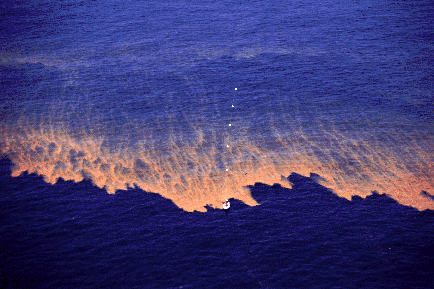
 | |||||
Dinoflagellates
Red Tide (Harmful Algal Blooms)
| |||||
Red Tide (Harmful Algal Blooms) | ||||
Dinoflagellates are the source of potentially fatal toxins called red tides. When these toxins are present in large numbers, they can change the water color, hence giving their name. The toxins are poisonous to a variety of vertebrate marine life, especially fish. They die relatively quick and easy when the dinoflagellate toxins enter their bloodstream through gills. Clams, oysters, mussels, and other filter feeding invertebrates are not affected by these toxins, but nevertheless store them in tissue and become contaminated. Therefore, humans can become affected by eating the animals that have ingested the toxins. Some common affects include eye, nose, and throat irritation. Detrimental neurological effects and other respiratory irritations are severe results of the toxins, and death may soon ensue.  | ||||